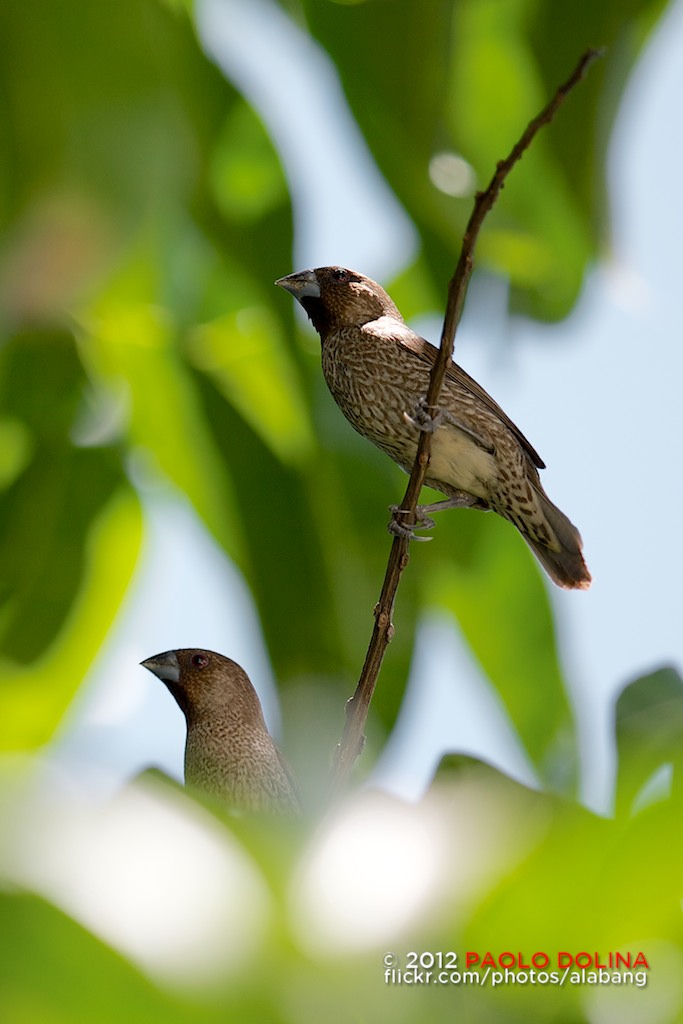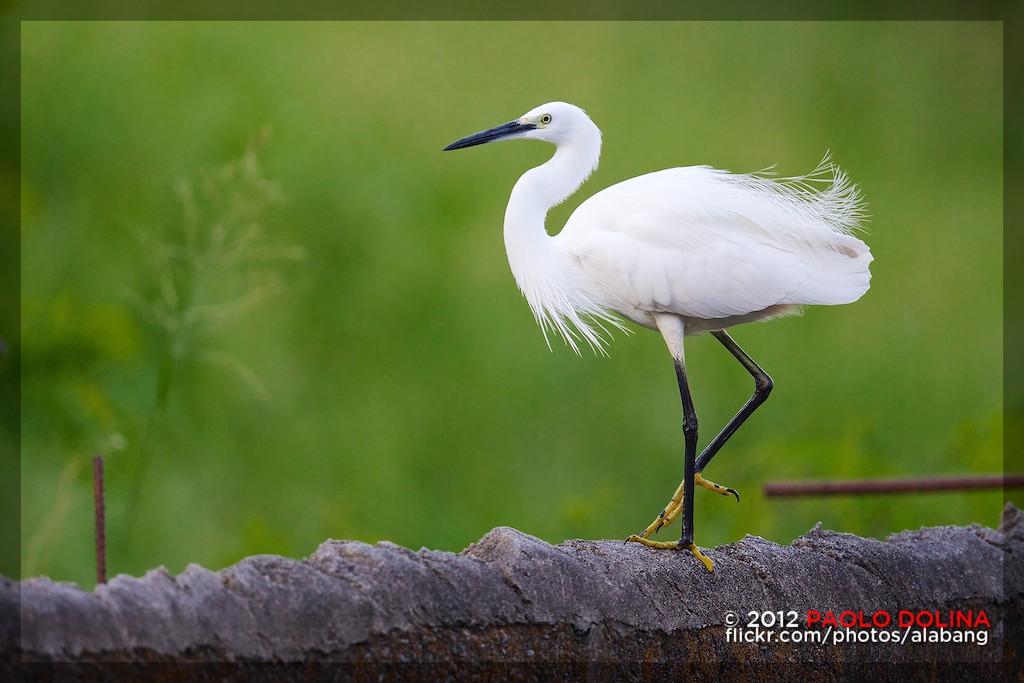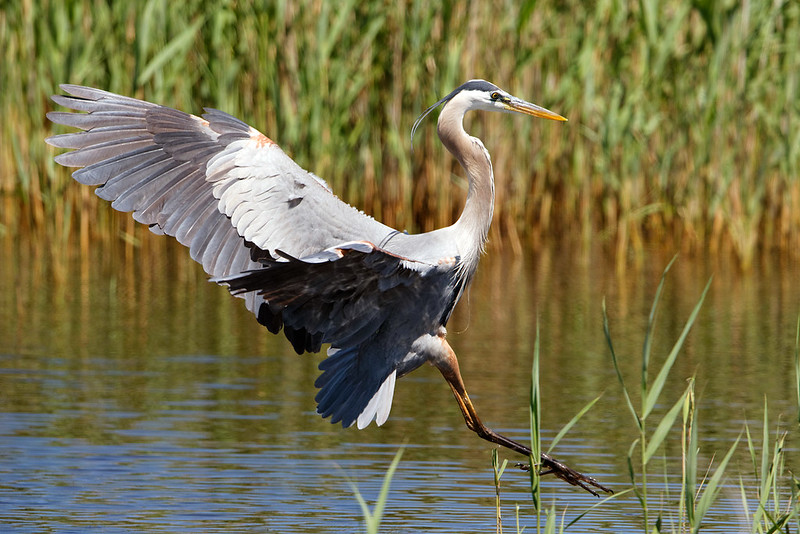You are using an out of date browser. It may not display this or other websites correctly.
You should upgrade or use an alternative browser.
You should upgrade or use an alternative browser.
Canon EF 600mm f/4L IS II USM
- Thread starter neuroanatomist
- Start date

Spotted Munia (Lonchura punctulata) by alabang, on Flickr
The Scaly-breasted Munia or Spotted Munia (Lonchura punctulata), known in the pet trade as Nutmeg Mannikin or Spice Finch, is a sparrow-sized estrildid finch native to tropical Asia. A species of the genus Lonchura, it was formally described and named by Carl Linnaeus in 1758. Its name is based on the distinct scale-like feather markings on the breast and belly. The adult is brown above and has a dark conical bill. The species has 11 subspecies across their range and differ slightly in size and colour.
This Munia eats mainly on grass seeds apart from berries and small insects. They forage in flocks and communicate with soft calls and whistles. The species is highly social and may sometimes roost with other species of munias. This species is found in tropical plains and grasslands. Breeding pairs construct dome-shaped nests using grass or bamboo leaves.
The species is endemic to Asia and occurs from India and Sri Lanka east to Indonesia and the Philippines. It has been introduced into many other parts of the world and feral populations have established in Puerto Rico and Hispaniola as well as parts of Australia and the United States of America. The bird is listed as of Least Concern by the International Union for Conservation of Nature (IUCN).
Source: http://en.wikipedia.org/wiki/Scaly-breasted_Munia
Taken in Muntinlupa City
Settings: 1/1000 ƒ/4 ISO250 600mm
Upvote
0

Little Egret (Egretta garzetta) by alabang, on Flickr
The Little Egret is more delicate-looking than any other heron-like bird which occurs in Britain. It is much smaller than a Grey Heron, with snowy white plumage, a long pointed black bill and black legs with strikingly yellow feet.
Habitat
Feeds by the edges of lakes, reservoirs, rivers, brackish lagoons and saltpans. Breeds in waterside trees and bushes.
Behaviour
The plumes which are present in spring serve to emphasise the threat and appeasement gestures given at the nest.
Migration
Most of the European population migrates west and south, mostly to north Africa but also, to an increasing degree, to the european side of the Mediterranean and the Atlantic coasts. After fledging, juveniles disperse almost randomly from July to September. This movement is presumably governed by prevailing feeding conditions.
Source: http://www.birdguides.com/species/species.asp?sp=20023
Location: http://en.wikipedia.org/wiki/Muntinlupa
Upvote
0
gary samples said:Starting the next generation she shoots pretty good a Little heavy on the trigger finger !
Good one Gary, your right need to start them Young, both my Lads are into it as well, oldest prefers Video, youngest Stills, I'm continuously amazed at how good they are, I think it's the Youth of today, they adapt so quickly to technology, I'm always asking my 13 year old how to get through a Menu.
Upvote
0
5DMK III 600f/4 V2, shot @ f/4.5 & 1/160th ISO1250
Right on Sundown, Mala Mala South Africa March 2013, had to use the 600 as the Mother was right on top of her young Cub & the Cub was not used to the vehicle, haven't had a lot of opportunity yet to use this Lens, mostly it's been the 300f/2.8 & 400f/2.8 V2's, but like it so far.
Right on Sundown, Mala Mala South Africa March 2013, had to use the 600 as the Mother was right on top of her young Cub & the Cub was not used to the vehicle, haven't had a lot of opportunity yet to use this Lens, mostly it's been the 300f/2.8 & 400f/2.8 V2's, but like it so far.
Attachments
Upvote
0
neuroanatomist said:"Cleared for Landing"
That's a very nice one neuroanatomist. Beautiful! 8)
Upvote
0

Little Egret (Egretta garzetta) by alabang, on Flickr
The Little Egret is more delicate-looking than any other heron-like bird which occurs in Britain. It is much smaller than a Grey Heron, with snowy white plumage, a long pointed black bill and black legs with strikingly yellow feet.
Habitat
Feeds by the edges of lakes, reservoirs, rivers, brackish lagoons and saltpans. Breeds in waterside trees and bushes.
Behaviour
The plumes which are present in spring serve to emphasise the threat and appeasement gestures given at the nest.
Migration
Most of the European population migrates west and south, mostly to north Africa but also, to an increasing degree, to the european side of the Mediterranean and the Atlantic coasts. After fledging, juveniles disperse almost randomly from July to September. This movement is presumably governed by prevailing feeding conditions.
Source: http://www.birdguides.com/species/species.asp?sp=20023
EXIF: http://www.flickr.com/photos/alabang/8573883185/#meta/
Location: http://en.wikipedia.org/wiki/Muntinlupa
Upvote
0
eml58 said:5DMK III 600f/4 V2, shot @ f/4.5 & 1/160th ISO1250
Right on Sundown, Mala Mala South Africa March 2013, had to use the 600 as the Mother was right on top of her young Cub & the Cub was not used to the vehicle, haven't had a lot of opportunity yet to use this Lens, mostly it's been the 300f/2.8 & 400f/2.8 V2's, but like it so far.
Awesome!
Upvote
0
arbitrage said:Thought I'd post a few eagles shot with this great lens...
Great shots arbitrage....And welcome to cr
Upvote
0
+1Click said:arbitrage said:Thought I'd post a few eagles shot with this great lens...
Great shots arbitrage....And welcome to cr
Lovely shots! Look forward to more
Upvote
0
arbitrage said:Thought I'd post a few eagles shot with this great lens...
Very nice, welcome to CR, Love the Eagles.
Upvote
0
I want one - have about 3/4 of the $ for it. Now only if there was a black friday sale soon ;D I can hope, can't I? Or should I say dream :
Upvote
0
dolina said:Actually that's very useful assessment. Is this the foot you are using now? I have this on the 400 at the moment.

I have the 4th generation foot on my 200-400. Much closer to the body (does not work well as a handle) but packs very well in the backpack
Upvote
0
arbitrage said:Thought I'd post a few eagles shot with this great lens...
Fantastic photos. You've just made my wallet start to worry ;D
Upvote
0
eml58 said:5DMK III 600f/4 V2, shot @ f/4.5 & 1/160th ISO1250
Right on Sundown, Mala Mala South Africa March 2013, had to use the 600 as the Mother was right on top of her young Cub & the Cub was not used to the vehicle, haven't had a lot of opportunity yet to use this Lens, mostly it's been the 300f/2.8 & 400f/2.8 V2's, but like it so far.
Stunning! I can't see myself having (or spending) the money to get a lens like this at this time in my life, but pictures like this are very compelling!
Upvote
0
arbitrage said:Thought I'd post a few eagles shot with this great lens...
Excellent pics!
Upvote
0
Similar threads
- Contains 1 staff post(s)
- Replies
- 110
- Views
- 17K
- Replies
- 185
- Views
- 29K








